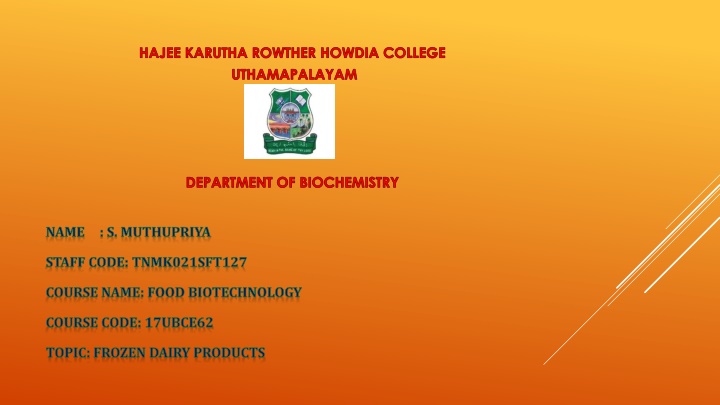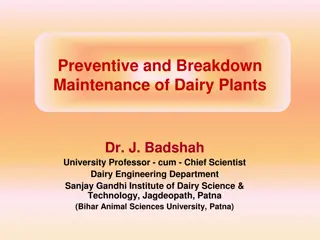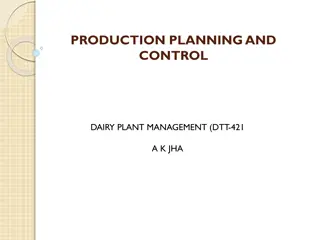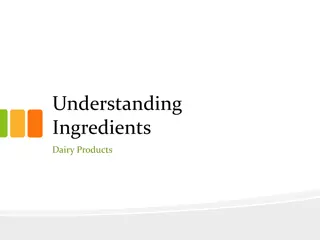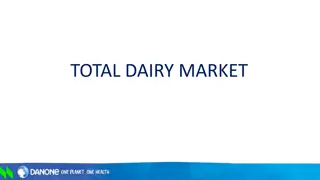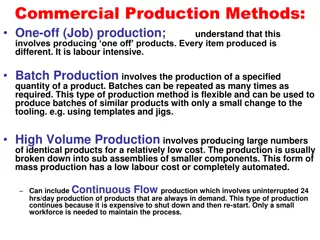Frozen Dairy Products Overview and Production Methods
Explore the world of frozen dairy products including frozen yogurt, soft serve, and more. Learn about the different types, ingredients, and production processes involved in creating these delicious frozen treats.
Download Presentation

Please find below an Image/Link to download the presentation.
The content on the website is provided AS IS for your information and personal use only. It may not be sold, licensed, or shared on other websites without obtaining consent from the author.If you encounter any issues during the download, it is possible that the publisher has removed the file from their server.
You are allowed to download the files provided on this website for personal or commercial use, subject to the condition that they are used lawfully. All files are the property of their respective owners.
The content on the website is provided AS IS for your information and personal use only. It may not be sold, licensed, or shared on other websites without obtaining consent from the author.
E N D
Presentation Transcript
HAJEE KARUTHA ROWTHER HOWDIA COLLEGE UTHAMAPALAYAM DEPARTMENT OF BIOCHEMISTRY NAME : S. MUTHUPRIYA STAFF CODE: TNMK021SFT127 COURSE NAME: FOOD BIOTECHNOLOGY COURSE CODE: 17UBCE62 TOPIC: FROZEN DAIRY PRODUCTS
FROZEN DAIRY PRODUCTS FROZEN DAIRY PRODUCTS A frozen dessert usually made from dairy products, such as milk and cream and often combined with fruits or other ingredients and flavors. A frozen dessert with less than 10% milk fat and the same sweetener content as ice cream. The principal frozen desserts are ice cream, frozen custard, ice milk, frozen yoghurt, sherbet and water ices.
Frozen yogurt is a cultured frozen product containing the same ingredients as ice cream. It contain 3.25 % milk fat and 8.25 % milk solids other than fat. Low fat frozen yoghurt contains between 0.5 and 2 % milk fat. Nonfat frozen yoghurt is limited to less than 0.5 % milk fat.
List List of of frozen frozen dairy dairy products products: : 1 1. . Soft Soft serve serve dairy dairy products products: : These include soft sere ice cream, icemilk, milk shake, mellorine, melted milk and custards. The actual freezing takes place at between negative 15 to negative 20 C for 3-5 minutes. The temperature is then increased to between negative 8 and negative 6 C.
2 2. . Parerine Parerine: : This product should not contain any meat products. It is prepared by the following methods. Blend the dry von fat ingredients in water Then heat the mixture to 49 C to facilitate mixing. Pasteurize the mixture at 71 C / 15 min Homogenize the mixture at 2800 psi
Cool the product to 4C and hold for 4 hours to facilitate aging Add the flavor components Freeze the mixture while adding air into the mixture. The over run should be less than or equal to the volume of the mixture. It is made from vegetable fat, sugar and cereals when adding emulsifiers add 0.2 % of it and up to 0.5 % of stabilizers.
3 3. . Frozen Frozen yogurt yogurt: : The yoghurt is manufactured the same way as any other normal yoghurt however, the stabilizer used here should be acid stable (eg: getatin) after the yoghurt is obtain, it is frozen to make the frozen product. The finished product should have 0.5 -2 % butter fat content and at least 8.25 % SNF. The final acidity should range between 0.5 0.9 % lactic acid. It should have a smooth texture and flavouring agents such as vanilla may be used.
4 4. . Ice Ice milk milk: : Made from sucrose and milk. The final product should have atleast 4 % butterfat, 2-7 % SNF, 12-15 % sugar, 13 % emulsifier and 0.6 % stabilizer. There should be 70 % water and the overrun should not exceed 85 %
5 5. . Sherbets Sherbets: : The sugar content ranges between 25 35 % sherbets have a relatively low overrun at between 30-40 % and the SNF content ranges between 2-5 % citric acid is the common acidulant fruit juices or artificial flavors can be used. The acidulant used should be able to withstand high acidity. Ex: gelatin. The product is frozen at - 23 C and aged for between 12 24 hours.
REFERENCE: Food Technology: An introduction book by Anita Tull. Food Processing Technology- Text book by P. Fellows
